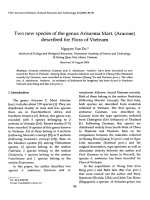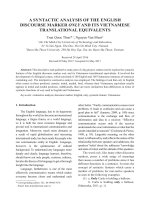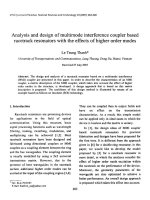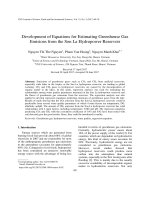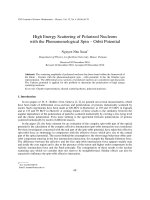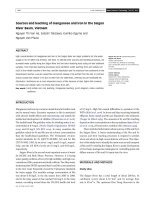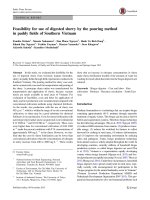DSpace at VNU: Non-commutative chern characters of the c -algebras of the sphers
Bạn đang xem bản rút gọn của tài liệu. Xem và tải ngay bản đầy đủ của tài liệu tại đây (1.23 MB, 11 trang )
VNT.J Journal o f Scicnce, M athem atics - Physics 25 (2009) 249-259
Non-commutative chern characters
o f the c*-algebras o f the sphers
N gu vcn Quoc Tho*
Ị'yeparỊmení o f M athem aiics, Vinh Universilv, Ĩ 2 Le Duan, ih ĩh d lv, iĩcínưnĩ
ReccÌNcd 8 Septem ber 2009
A b s tra c t.
We p rop ose in this paper the construcion o f non-com m utalive Chcrn characters
o f i he C ' —a l g e b r a s o f s p h e r e s a n d q u a n t u m s p h e r e s .
T h e Hnal c o m p u t a t i o n gi ve s us c i e a r
r e l a t i o n With t he o r d i n a r y Z / ( 2 ) - g r a d c d C h c r n c h r a c t e r s o f t o r s i o n o r t h e i r n o r m a l i z c r s .
Kc}^v()rks: C haracters o f ĩhe c * —algebras.
1. I n tr o d u c tio n
For coinpacl Lie groups the C hem character cfi : /v * ( G ) ® Q — ^ Ỉ I p Ị ị { C ; Q ) were construcled.
in [4|-f5] wc com puted the non-conimutativc Clicrn characters o f compact Lie goup c * —algebras and
o f compact quantum ụroups, which are also honiomorphisiiis from quantum A '- g r o u p s into entire
currciu
periodic cyclic
h o m o lo g y o f group
c
* - a l g e b r a s (resp., o f C * - a ! u c b r a q u a n tu m groups),
(7/(- : K J ( ' * ( C ) ) — - / / A \ ( C * ( G ) ) ) , (resp., chc* : A \ ( C ; ( C ) ) — ^ / / / s \ ( c ; ( ơ ) ) ) . We obtained
viiiiO ilic
icspuiKliii '4 ali;cl)iaic
ihfiig '■ h * { ( J * ( U ) j —
Ỉ Í J\ [L' * [Li) ))^ which coincidcs
with
the
l-cdosov-C'unt/-
Ọuillcii
formiila
for C l ie r n
characters
[5].
W hen
A
-
C*{G)
wc
first
com puted tlie / v - u r o u p s o f c * (G ) and the / / L \{ C ^ {G) )' T hereafter we com puted the Clicrn charactcr
r ile - : h \ { C U ( > )
- Ỉ Ỉ E ^ { C * { G ) ) ) as an isomorphism modulo torsions.
Usinir tiie results from [4|-[5], in this paper vvc com pute llic non-com m ulative Chern characters
^
: A ^ ( /l)
the
— > / / / : > ( / ! ) , for two eases .4 = c * ( 5 “ )), tlic C * - a l u c b r a o f spheres and .4 “
- a l g e b r a s o f quantum spheres.
character CỈI : K * { S " )
For com pact t»roups G -- (){ii
f
1), the C hem
Q — » I ỉ pỊ ị { S^ ^ \ Q) o f llic sphere 5 ” - 0 { n f i ) / 0 { 7 i ) is an isomorphism
(sc. f 15]). In the paper, w e describe two Chern character hoiiiomorphisms
and
chc- : A',(C';(5")) —
Ỉ^ÍÌKÚI: ihonguNcnquoc Í/ gm ail.co m
219
//E .(c;(5")).
N Q. Tho / V N V Journal o fS cicn c e, Síaihcm ưíics - f^hvsics 25 (2009) 249 -2 5 9
250
Finally, \vc show that there is a coinmiitvative diagram
A'.(C(AVJ)
//E.(C(AVJ)
(Similarly, for -4 = c * ( ” ), we have an analogous com m utalivc diagram with i r
\v
X
X
s ’ o f place o f
5 " ) , from which we deduce that c lic - is an isomorphism modulo torsions.
We now briefly review he structure o f the paper. In scclion 1, we com pute the C h e m chracter o f
the c * - a l g e b r a s o f spheres. 'I'lie computation o f C h em character o f
is based on two crucial
points:
i) Because the sphere S " - ( ) { n f \ ) / 0 { 7 i ) is a homogeneous space and C " - a l g e b r a o f .9^ is
(he transformation group c * - a l g e b r a , follwing J.Parker [10], we have:
ii) U sing the stability property theorem
and I
I
in [5], we rcduce it to the com putation o f
c * - a lg e b r a s o f subgroup 0{ n) in 0 (n I- 1) group.
In section 2, we com pute the Chern characlcr o f c * - a l g e b r a s o f quantum spheres. For quantum
sphere 5 ^ , w e define the com pact quantum c * - a l g e b r a s
where t is a positive real n u m b e r
Thcreafier, we prove thát:
where
is the elemenlar>' algebra o f compact operators in a separable infinite dim ensional
Hilbert space
i
and
w is ihe Weyl o f a maximal tom s T „ in S O { n ) ,
Similar to Section 1, vve first com pute the h \ { C * { S ' ^ ) and Ị Ị E ^ { C * { S ' ' ) , and we prove that
die- : /ú (c;(5 ”)) — Iỉh\{c:isn)
is a isomorphism modulo torsion.
N otes on N o ta tio n : For any compact spacc -V, we write /v*(A ’') for the Z / ( 2 ) - graded topo
logical A ^-theo ry o f X . We use S w a n ’s theorem to identify /v*(A ') with Z / { 2 ) - graded /v*(C (-Y )).
For any involution Banach algebra A , K ^ { A ) , H E ^ { A ) and I Ỉ P ^ { A ) are Z / ( 2 ) - graded algebraic or
topological A '- g r o u p s o f A , cnire cyclic lioinology, and periodic cyclic homology o f A , respectively.
If T is a maximal torus o f a compact group G , wilh the corresponding Wcyl group w , write C ( T )
for the algebra o f com plex valued functions on T . We use the standard notation from the root theory
such as p ,
for the positive highest weights, etc,.. We denote by A / t the norm alizer o f T in Ơ , by
N the set o f natural num bers, R the fied o f real numbers and
the standard
c
the field o f com plex num bers, i ^ ( N )
space o f square integrable sequences o f elem ents from A , and finally by C* { G ) we
denote the com pact quantum algebras, C* { G ) the c * - a l g e b r a o f G.
N O. TĨU) / VNU J o u n u d o f S d c n c e , M a them atics - Physics 25 (2009) 249-259
2. N o n -com m u lativ e Chern characters of c *
251
algebras o f spheres.
In this section, we com pute non-commutativc C h c m characters o f c * - a l g e b r a s o f spheres.
Let A be an involution [^anach alucbra. We construct the non-com m utative Chern characters chc* ■
K ^ ( A ) — ►I I E J A ) s and show in [4] that ỉbr c * - a l g e b r a C * { G ) o f com pact Lie groups G , the
Ciiern charactcr cìì('* is aii isomorphism.
P ro p o sitio n 2.1. ( |5 |, Tlìcorciìì 2.6) Lei / / he a sep a ra b le liilh e r t sp a ce a n d B cm arb itra ry Banach
space.
where
Wehave
K .(tcựỉ))
^
7v\(C);
/V \(Ỡ 0 /C (//))
^
K .Ụ Ì)
//£ \(A C (//)) ^
//£ .(€ );
ỈIE.{B®KựI)) ^
HE. { D) ,
K. ( H) is the clem en ííỉỉy algebra o f com pact o p era to rs in a sep a ra b le ifijim te d im e m io n a l
ỉỉỉlb e rt sp a ce II.
P ro p o sitio n 2.2. ([5], Theorem 3.1) Lei .4 be cm involution B anach algebra with unity. There is a
('hern ch a ra cter hom om orphism
chc- ; h \ { A ) — ^ IIE. { A) .
P ro p o sitio n 2.3. (Ị5), rheoreni 3.2) Let G be an com pact Stroup a m i T a fix e d ìììaxim al torus o f
(Ĩ \viih Weyl i r
A ' t / T . Then the Chern character rh(^^ : / \ * ( C * ( G ) ) ^
isoìnorpỉìism m odulo lorsiofis i.e.
rhr- : h \ { C * { G ) ) 0 C
/ / E . ( C * ( G ) ) . is cm
///i.(C * (G )),
vvhiJi CUN be iiicntijicd wiih ific cIu.sMcai Chern charactcr
c h r- : A '. ( C ( A t ) ) —
/ / / • : . ( C ( A ^ t) ) ,
ỊỈìiỉỉ is also an ìsoỉììorphic m odulo torsion, i.e
rh : A \(A /'t)Cs^C
Now, for 5 ” - (){ìL I l ) / 0 ( / i ) , where 0 { i i ) , 0 { n f 1) are the orthogonal matrix groups. We
detDlc by T „ a fixed maximal torus o f 0 ( ; ỉ ) and A^Xn the normalizer o f T „ in 0 ( n ) . Following
[Proposition 1.2, there a natural C h em character chc* : / Ú ( C ( 5 ' ' ) ) — ^ I Ỉ E ^ { C { S ^ ) ) , Now, we
con pute first k \ { C ( S ' ' ) ) and then H E ^ { C { S ' ^ ) ) o f C * - a l g c b r a o f the sphere
i*ruposition 2.4.
H E , ( C { S ’'))
H]],ẶTn)).
Pro ự We have
///:.( C '( 5 " ) )
-
/ / £ \ ( C ( 0 ( n - f 1 ) / 0 ( h )))
//E .(C * (ơ (n )) ® Kl{L^{0{n + l)/ơ (ri))))
252
A '. ạ Thu / I 'M J Jou rna l o / S c i e m v . Mưihcniưiics - P hysics 25 (2009) 249-259
(in virtue of, llie K { ỉ ? { 0 { ì ì \ 1 ) / 0 ( r ỉ ) ) ) ) is a c * - a lg c l.r a com pact operators in a separable 1lilhcrt
spacc I ? { ( ) { n + l ) / 0 ( n ) ) )
ỈIE,{C{(){n)))
(by I>n)Ị)().sition 1.1)
IỈE.{C{Mr'^)
-
(s e e Ịõ Ị).
Thus, we have H E , { C ^ { S ’‘)) ~ / / £ ' * ( C ( . V t J ) .
A p a r t f r om t ha t, b e c a u s e C ( A ' t ) is tlicn c o m i m i t a t i v c c * —a l i ỉ c b r a . b y a C i i n t z - Q u i l l e n ’s r e s u l t
[I], \vc have an isomotpliisni
//n (C ((A 'T „ ))S ^ //ô » (A /'T j).
Moreover, by a result o f Klialkhali [8],[9], we have
///> .(C ((.V t „ )) = / / / % ( C ( ( A ' t J ) .
W'c liave, hence
ỈỈE,{C"{Sn)
~
// £ '* ( C ( A /'t J ) = / / P . ( C ( ( A ' t J )
R e m a r k 1. Bccause ỈỊ]jỊị{AÍT ) is the dc Rham coliomology o f T n , invariant under the action o f the
Weyl group \ \ \ following Watanabe [15], we have a canonical isom orphism ỉ ỉ p ] ị { T n ) ~ I Ỉ * { S O n ) l —
A (X3 ,X 7 , ...,a- 2 z+3 ), where X2 x+ 3 = cr*(Pi) € / / ^ " ^ ^ ( 5 0 ( n ) ) and rr*
i r { B S O { n ) , R) — ►
H * { S O { n ) , R ) for a com m utative ring /{ with a unit 1 G 1Ì, and Pi —
t ị , l ị ) e / / + (/iT n Z )
the P onlrjagin classes.
Thus, we have
Proposition 2.5.
/ v. ( C ( 5 " ) ) - / v *(7í t J ) Proof. \Vc have
/ Ú ( C ( 5 ” ))
h\{C {(){nil)/0{u)))
-
h\{C*{0{n))® iC{L\0{n i l)/0{n))))
^
A ', ( C * ( 0 ( tí)))
~
A \(A /t
)
(see [10])
(by I ’r o p o s iti o n 1.1)
(l->y L o i i i i n a 3 . 3 , f r o m
[5]).
Thus, A \ ( C ( 5^0 ) = / w ( A t J .
R e m a r k 2. Following Lem m a 4.2 from [5], w e have
/v .(A /tJ
where (3 : R { S O { n ) ) — > /v
=
ỈC{SO{n \ l))/Tor
=
A ( / 3 ( A i ) , / J ( A „ _ 3 , £„4-1),
( 5 0 ( n ) ) be the homomorphism o f Abelian groups assigning to each rep
resentation p : S O { n ) — » U { n - \ - 1) the homotopic class ị3{p) = [inp] G [ 5 0 ( n ) , t / | = K ~ ^ { S O { n ) ) ,
where i „ ; [/(71 + 1) — * Ư is the canonical one, U { n + 1) and Ư b y the n -
groups respectively and
€ A '“ ^ (5 Ơ (7 1 + 1)). We have, finally
A'*(C*(5")) s A (/3(Ai),....,/y(A,._3,en+i).
t h and in fin ite unitary
N . ọ Tho / I'N U J o u r n a l of Scwnce, M ath em a tics - Physics 25 (2009) 249-259
253
M(ircovcr, the Chern charactcr OỈ S U ( n i 1) was compiilcd in [14], for all ì i ỳ \. Let us rccall
the rc.suli. Define a function
ộ : N x N x n — ^z,
uivcii bv
k
^
^
,1
J'heoreiii 2.6. Ỉ.CÍ T n he a fix e d maximal iorus o f 0 { n ) a m i T the fix e d m axim al torus of S ( ) [ n ) ,
with Wcyl ị:,n)ups i r
A t / T , th e C hern characier o f C"‘[S'^)
rhc^ : h \ { c * { s n )
//£' *(C *(5”))
I.s Ufi ỉsíììtiorphism, ịỉìven by
rhc-ifW )
-
^ ( ( - l ) ' - ' 2 / ( 2 i - l)!ự.(2,i f 1 , ẳ ; , 2 0 x 2 h i
rhc.{€„.,^)
-
^
1 ”
^ ( ( - l ) ' “ ' 2 / ( 2 i - l ) ! ) ( ( ^ ^ 0 ( 2 u + 1 ,A :,2 0 x ,,h .
1=^1
( k = 1,
n-1);
1=1
Proof. By IVoposilion 1.5, we have
A-.(C*(5")) ^ K , ( C { M r J ) =
and
//E .( C * ( 5 '') ) ^ / / E . ( C ( ^ / J ) ^ H h n W r J
(l>y P r o p o s i tio n l.-l).
Now. consider the com m u tative diagram
K.{C"{S"))
Ị ỉ i : , { C ' { S ’'))
h -{M r„ )
ỉỉhui^-in))-
Moreover, by the results o f W atanabe [15], the Chcrn cliaractcr c/i : A '* ( A t „ ) © C — ' ỉỉ])ii{ -^ T „ ))
is an isom orphism
Thus, c/ic* : A ', ( C * ( 5 " ) ) — > Ỉ I E . { C ' { S " ) ) is an isomorphic (Proposition 1.4 and 1.5), given
by
chc-{P{\k))
=
f ^ ( ( - l ) - ' 2/ ( 2i - I ) ! ) ộ ( 2a + 1, ^ - , 20X 2,+1 ( k = l ,
1-1
1:^1
i= l
n - 1);
N.Q. Tho / VNU Jo u rn a l o f Science, M athem atics - /Vỉv.v/c‘.v 25 (2009} 249-259
254
where
H E , { C ^ S ' ‘))
5^
A (j'3,X 7,...,X 2,4 3).
3. N on-com m utative C hern charactcrs o f c * - a l g e b r a s o f quantum spheres
In this section, w e at first recall definition and main properties o f com pact quantum spheres and
their representations. M ore precisely, for
S'\ we define c* ( 5 " ) , the
spheres as the C * - c o m p le ti o n o f the ’ - a l g e b r a
C” - a lg e b r a s
o f compact quantum
with respcct to the 6 ” - n o r m , where
is the quantized H o p f subalgebra o f the Mopf algebra, dual to the quantized universal enveloping
algebra Ư{Ợ), generated by matrix elements o f the U{C/) modules o f type l ( s e e [3]). We prove that
where fC{Hyj t) is the elementary algebra o f compact operators in a separable infinite dimensional
Hilbert space
and Ỉ Ỉ ' is the Weyl group o f 5 " with respect to a maxim al loriis T .
A fter that,we first com pute the / ^ - g r o u p s A ',(C * (S '* )) and the I I E ! , { C * { S ' ' ) ) , respectively.
Thereafter we define the Chern character o f c * - a l g e b r a s q'lanlum spheres, as a homom orphism from
A ' , ( Q ( 5 " ) ) to H E \ { C * { S ' ‘)), and wc prove that d i e - ■ A '. ( C ; ( 5 '" ) )
isomorphism modulo lorsioii.
/ / / Ỉ , ( Q ( . S ’'‘)) is an
Let G be a com plex algebraic group with Lie algebra Q = L icG ' and £ is real number. £• :/ - 1 .
D efin ition 3.1. ([3], Definition 13.1). The qu a n tized fu n ctio n alg eb ra T e { G ) is the subal'^ehra
o f the H o p f algebra d u a l to Ue{G), g en era ted by the m a trix elem ents o f the fin itc -d im o isio n u l
U r(G )—m odules o f type 1.
For compact quantum groups the unitar>' representations o f T ^ { G ) arc param etcri/cd b \ pairs
(w, t), where t is an elem ent o f a fixed maximal torus o f the compact real (brin o f c and u.' is a element
o f the Weyl group w o f T in G.
Let A G
be the irreducible i/ £ ( i / ) - m o d u l e o f type 1 w ith the lii«hcst wciuht A.
Then K ( A ) admits a positive definite hcrmitian form'
such that X V \ , V 2 ) =
V\ , V <2 €. Vị :{ằ), x € U{G). Let
be an orthogonal basis for weight space
is an orthogonal basis for Ve(X). Let
r(x ) =
o f ^^(À). Then the matrix elements c ^ ,
ft e
lor i'll
. Then
v ị ) be the associated matrix elements
A runs tlirongli p + , w h ile (/i, r ) and (í/, >s) runs
independently through the index set o f a basis o f Ve(A) form a basis o f J^Ị^{G){SQC [3]).
N ow ver>' irreducible ‘ -re p re s e n ta tio n o f T e { S L 2{C.) is equivalent to a representation bclonginụ
to one o f the following two families, each o f which is parameterized bv 5 '
{/ G c \ | / | = 1}
i) the family o f one-dim cnsional representations Ti
ii) the family 7T( o f representations in £^(N)(sec |3J).
Moreover, there exists a surjective homomorphism J^e{G) — f
(S /> j( C ) ) induccd h\ llic
natural inclusion S L 2C
G and by composing the representation 7T_1 o f J ^ ^ { S L 2'C) with this
homomorphic, we obtain a representation o f J-\{G ) >n £^(N) denoted bv TTs , where Si appears ir. the
reduced decom position UJ = ,s,,, s, 2 , M o r e
precisely, TTa : T e { G ) — » £(ế'^(N )) is o f class
CCR(see [11]),i.e. its image is dense in the ideal
con.pact operators £ ( i ^ ( N ) ) .
t
N.Q. Tho / V N U Jo u r n a l of Science. M a th em atics - Physics 25 (2009) 249-259
255
Then representation Tị is onc-dimcnsional and is o f the form
Tt{Ci^s4L.r)
ổr„,<5^,,^exp(27Tv/^/i(x)),
( 'x ị ) ( 2 7 T \ / ^ / í ( x ) G T , for X e L ie T ( s c c [3]).
if /
P r o p o s itio n 3.1.
Every’ irreducible u n ita ry representation o f J~e{G) on a separable
([3], 13.1.7).
ỉĩilh c r t .space is the co m p letio u o j a unitarizable highest w eight reprt\se?ìíaíion. Moreover, two such
representation are e q u iva len t i f a n d only i f they have the sa m e highest
P ro p o s itio n 3.2. ([3],13.1.9) Let UỈ ==
b e a reduced d eco m p o sitio n o f an elemeniuj o f
the H eyl group U ' o f G . Then
u The ỉỉilh c r t sp a c e te m o r product f)^ I ~ lĨỊị
Tĩs s .......®7ĨS
rưpre.scniaíiotì o f T ẹ {G) w hich is associated to the S ch u b ert cell s.^\
ĩi) I p to equivalence, the representation
irreducible
I does not d ep en d on the choice o f (he reduced
deci. m p o s itio n o f u j \
Hi) Every’ irred u cib le *-re p re se n ta iio n o f J^e{G) is eq u iva len t to so m e
The sphere
can b e realized as the o rbit under th e action o f the com pact group S U { n -\- 1)
of the hiị:^hest w eight vec to r
Vo
in iis ĩuỉiural (?i ~f \) - d i m e m i o n a l representation V
o f S U { n -f 1).
// /r.si
0 < 7', 5 < n , are th e m a trix entries o f V , the a lg eb ra o f fu n c tio n s on the orbit is g en erated
by (he entries in the "first co lu m n ” tsQ a n d their com plex coiijugates. In fa c t,
C [/oo.
w here
" is ihe fo llo w in g eqiùvaỉetĩce relation
n
^sO^sO = 1*
5=0
P ro p o sitio n 3.3. ([3], 13.2.6). The * —siruciure on H o p f alg eb ra / * t ( S L 2 (C )) , is given by
w here 7V.S is the m a trix o h ta ifw d by removing:, the
D efin ition 3.2. (Ị3J,13.2.7). The
hy
row a n d the
colu m n fr o m T .
-s u b a lg e b r a o f ^£(5L „4-1 (C )) g en era te d by he elem ents iso
ỉỳ ~ 0,
is c a lle d the q u a n tized a lg e b r j o f fu n c tio n s on (he sphere 5 ^ , a n d is denoted
It is a q u a n tu m s L r i \ - \ ( C ) —space.
We set
-- /.,0 from now on. Using Proposition 2.4, it iseasy to see that the following relations
hold in ^ , ( 6 ’” );
Z sZ r i f r < s
if r ^ s
+ (e - 2 + 1)
= 0
H e n c e , h a s [ C P ) as its defining relations. The construction o f irrcducible "-rep resen tatio n
is given by.
T h e o re m 3.4. ([3],13.2.9). Every^ irreducible *-re p re se n ta tio n o f
of the fo llo w ing:
i) the o n e-d im en sio m il representation p o t
i f r > 0,
t e
of
is equivalent exactly to one
g iven b y Po t i ^ o) ~
Pot(K) — 0
A-.Ọ Tho / \ 'NU Jo urn al o f Science. Miỉíhernưtics - Ị^hysics 25 (2009) 249-259
25()
ii)
ĩh c r c p ĩ v s c n ĩ d í ĩ ũ ì ĩ />() ị
1 ^ r íí n,
Oĩì íh c l ĩ i l h c r í s p a c e íc ìĩs o r p r o d u c t / -^('^1) ■
/ c
give by
P r Á - l ) { ( ' k , ® . .. : í
I
.V,
Ạ
r
(1 -
‘ ẽ:‘
♦‘ +' > ) 0 ... s
=
a
H + 1 ® f'A-,,2 ®
if .s < r
® ... ® PAv
i f .s- -
0
r
if ,s > r.
The representation fh)Ị is eqiiivalenỉ /() the restriction o f th e representation Ti o f !F ^(S Ln-\\\ C. ))
(cf.2.3); a n d or ì' > (ì, f)j-1 is equivaìent to ihe restriction o f TTs^ y.
%-
From Theorem 2.6, we have
kcr/)^,/ -= {()},
(*',i)eiV'x7-
i.e. the representation ©;^eu I'f
is faithful and
f 1 if u; -- (’
(liin (). t ' ' \
We recall now ihc definition o f compact quanlum o f spheres
D efinition 3.3.
*—algebra
c* —
algebra.
The c * —algebraic com pact quantum sp h ere c * ( 5 “ ) is he c * —com plciion oj the
with respect to the C * ~ n o rm
ll/ll-sup i|M/)ll,
p
where p runs through the*— representations o f
(cf.. Theorem 2 6) a n d ihe norm on the riglii-
hcmd sid e is (he operator.
It sufTcies to show that ll/ll is finite for all / €
for it is d e a r that ||.|| is a C * - ii o r n i,
i-C- ll/-/*ll — \ \ f\\ ^‘ We now prove that ibllowing result abo ut he structure o f compact quantum
C * - a l g c b r a o f sphere S ' \
I 'h e o r c m 3,5. ỉilíh Pìoíaíion as above, vt't' have
c ; ( 5 " ) ^ c ( 5 ') 0
0
r
where C ( 5 * ) is (he alịiehra o f com plex valued co n tin u o u s fim c tio tis on
a n d K \ ỉ l ) ideal o f com paci
operators in a separable m ih e r t space //.
Proof.
Let UJ —
be a rcduccd decom position o f the elem ent Ú,’ G i r into a product o f
reflections. Then by Proposition 2.6, for r > o, the representation
t is equivalent to the restriction
0
Í
7T.,^ ®....®7T5^ ® T t, w here 1ĨSX is the composition o f the hom om orph ism o f T'e(G) onto / ’ê ( 5 /.2 ( C ) )
and the representation 7T_1 o f J^ị:{SL ‘2{C)) in the iỉilb c rt sp ace
and the family o f onc-
dimensional representations T(, given by
7Ị(a) -
T; (0) - 7Ị(c) - 0, 7 ĩ(ư ) -
where t G 5^ and a j j , c , d are give by: A lgebraJT £(5L 2(C )) is generated by the matrix elements o f
type [
ỵc
^
uy
. Hence, by construction the representation
7 T , . : C ; ( S ' ‘) -------- ►c ; ( S L , ( 0 )
Í = TTg
’
*Ỉ
0 .... ®7ĨS
£ (ế'^(N )S ^).
® 7i- T hus, vvc have
*k
N . ọ Tho / V N U Jo u r n a l o fS c ic n c c . M ath em atics - Physics 25 (2009) 249-259
257
Now, TTs is CCR (see, 111Ị) and so, w e have 7rs,(C'*(5") ~ /C(//^,(). M oreover Tt{C*{S'^)) —c .
I Icncc.
/-,(C (^ " ))
=
(7T,._ ' v . . . 0 7T,.^0 7 ; ) ( Q ( S " )
= rr,., (c;(S")) ®... s 7t,./(c;(S'‘)) 0 T((c;(5 '*))
I C{ I L, t ) ,
-
where n ^ . j = //«, 0 .... © H s, ® c .
p ^ A C : { S ’')) = K . ụ U t ) .
T hus,
1Icncc,
r(D
/*0
Now, recall a result o f s. Sakai from [11]: Let -4 be a com m utative c * - a l g e b r a and B be a
Then,
c* -a lg e b ra .
B ) ~ ,4 Cv /i, where ÍÌ is the spectrum spacc o f A .
A pplying this result, lor B — AC(7 /^ / ) ^ /C and A — C ( U ' x 5 ^ ) be a com mutative c * - a l g e b r a .
*
I'hus. we liave
c
Now, vve first com pute the A \ ( C * ( 5 ” )) and llic I I E ^ { C * { S ' ' ) ) o f c * - a l g e b r a o f quantum sphere 5'^
P ro p o sitio n 3.6.
/ / A \ ( c ; ( S ' - ) ) ^ / / ; „ , ( U ' x ố ’') .
Proof. Wc have
Ỉ Ỉ E A C : ( S ’'})
0
r
=
// E ,( C ( 5 ') ©
=
/ / £ . ( C ( S ’' ) © / / E . (
—
H E . { C { \ V X 5 ‘) 0 / C
^
/ / / T . ( C ( i r X 5*)).
! C{n^^t )dt )
r
0
IC{ỈUt)dt))
(b y P r o p o s i tio n 1.1)
Since C (U '' X s ' ) is a com m utative ’ - a l g e b r a , by F’roposition 1.5 §1, we have
/ / E . ( C ; ( S " ) ) ^ H E , { C { \ V X 5 ‘ )) ^ H h n i ^ V X 5*))'.
Proposition 3.7.
K,{C*{S’')) ^ IC(\V
X 5^).
N.Q. TỊìo / VN U Jo u rn a l o f Science. M ưíhcmưỉics - Physics 25 (2009) 249-259
258
Proof. Wc have
A\(c;(S'‘)) = A\(C(S‘)Q
0
riC{U^^t)df)
U' ' ^
) dt ) )
^
K,{C{\V x S ^ ) @I C
^
A '.( C ( ir X S ') ) .
(1)V P r o p o s i t i o n 1.1)
In result o f Proposition 1.5, §1, we have
h \iC { \V X 5 ') )
K . { \ v X 5 ‘ ).
Theorem 3.8, IFiih rwiaiion above, the Chern chanicỉer o f C * —algebra o f quantum sphere
chc- : A \ ( C
(S") —
ỉỉi:.{C
c
(S")
( 5 ”))
is an isom orphism .
Proof. By Proposition 2.9 and 2.10, we have
H E , { C ; { S ' ^ ) ) ^ H E , { C { \ V X 5 ‘ )) ^ i / ; j / i ( i r X 5 ' ) ) ,
/ : . ( c ; ( 5 " ) ) ^ A '.( C ( ir
X
5 ‘ )) ^ I C { \ V
X
5 * )) .
Now, consider the com mutative diagram
/c * (c ;(5 " ))
ỈỈE.{C:{S^^))
K J C ( \ V y s^))
Í Ỉ E J C ( \ V X S' ))
A '*(U ’ X 5 ‘)
^
M o re o v e r, follvving W a ta n a b c [ 1 5 ] , the e ll : A ' * ( i r X 5 ‘ ) :-; C — »
X 5 * ) is an is o m o r p h is m .
Thus, chc* : h \ { C *£ (5'*) — » H E ^ { C
(5'” )) 'S an isomorphism.
A c k n o w le d g m e n t. T he author would like to thank Professor Do Ngoc D iep for his guidance anti
encouragement during this paper.
References
|1]
|2J
[3]
[4|
|5 |
[6|
J. Cunlz, Hntice cvclic cohoniolog\ of Banach algebra and characl^T of ớ “ Suiĩimablo i-rcdhoni tìKxlulcs. K-'rhcai'y., 1
(1998) 519.
J. Cunl/, I). Quillen, The X coinplcx 0 Í IỈ1C unuvcrsai cxtci.iions. ỉ^irpm nt i\ỉatfi. Inst. Vni. U tidtlbtg, (1993)
V. Chari, A. PrcsslcN. A guide to quantum (j7X}ups, Cai.ibriJgc Uni. Press, (1995).
D.N. Diep, A.o. Kuku. N.Q. Tho, Non-coininulativc Chcm ciiaractcr 0 Í compact Lie group c*-algeb ras. K- 'rỉieory.
17(2) (1999) 195.
O.N. Dicp, A.o. Kuku. N.Q. Tho, Non-comniutative Chcm characlcr of compact quantum group, K- Thcor'y, 17(2)
(1999), 178.
D.N. Dicp, N.v. Thu. lloniotopy ivariancc of entire cumt cyclic homology, Vielĩiarn J. o f Math, 25(3) (1997) 21!.
N Ọ. Tho / V N U J o u rn a l o f Science, M aihcm atics - Physics 25 (2009) 2 49-259
|7|
|8|
110|
|H{
[I2|
|13|
114|
I li>|
259
Ị) N, Dicp, N.v. Thu. I jitirc homology of non-commulativc dc.Rhani curcnts, ỈC T P , ỊC /9 6 /2 I4 , (1996), 23pp; to
appirar in ỉ^iiblicaíioĩi o f C FC A, H anoi C ity V ietnam N ational Iniversily {\991).
M. Klialkhali. On the inlive c>c!ic coh(>!iiolog\ of Hanach algebras: 1. Moita invariancc. M athem atisches Inst. Uni.
Ilv.idclbcry., 54 (1992) 24.
M Khalkhali. On ihe intivc c>c!ic cohomology of iianach algebras: II. Honiotopy invariancc, M a t h e T n a t i s c h e s Inst.
I 1 11 . Ucidelbf rg. 54 (1992) 18.
J i*:.ctkcr. Translormation group C’*~a!gcbra: A scicctivc sur\c\. C ontem porary M athem atics., Volume 167 (1994).
S. ..akai, ( " —algebras and w * —algebras, Sprincr-Vcrlag Berlin. Heidelberg New York, (1971).
N A' Thu, Morila invarianc’c of entire curronl cyclic homology, V ietnam J. M ath., 26:2 (1998) 177.
NA' ĩhu, líxaciness ol cnũrc current cyclic honiloiỉỴ. A cta M ath Vic-lnamica.. (to appear)
T Waianabc. C'hem charactcr iin compact l.ic groups of low rank Osuka J. M ath., 2 (1985) 463.
'I' Waianahc, On the Cilcm characicr of s\mmctric space related o S U (n ), J. Math. K yoto Uni, 34 (1994) 149.

